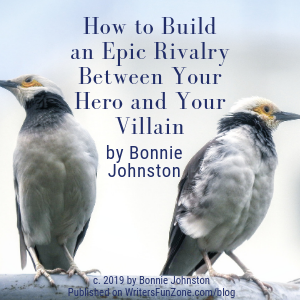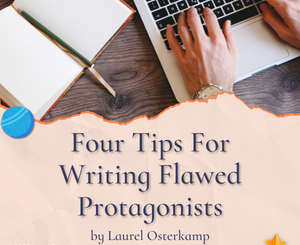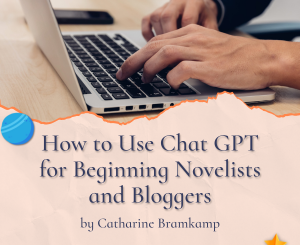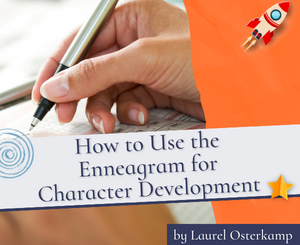How to Build an Epic Rivalry Between Your Hero and Your Villain by Bonnie Johnston
Today we welcome guest writer and writing teacher, Bonnie Johnston, to Writer’s Fun Zone, who is stopping by to chat about “How to Build an Epic Rivalry Between Your Hero and Your Villain.” Enjoy!
***
Deepen Characterization, Intensify Conflicts, and Write Stories Readers Crave
JK Rowling did it.
Victor Hugo did it.
Sir Arthur Conan Doyle did it.
It’s one of the reasons that all three of these authors were massively successful.
Rowling, Hugo and Doyle created epic rivalries between their heroes and their villains — deep, multilayered relationships that locked good guys and bad guys together in high-stakes conflicts that couldn’t be easily resolved.
Not only do these rivalries generate compelling conflicts powerful enough to drive big stories and big series, they also take the reader on a deep dive into the psychology of both hero and villain.
Epic Rivalry
We get to know Harry Potter better through Harry’s struggle to understand how Voldemort became an evil wizard.
We love Sherlock Holmes more when we see him resist the temptation to join Moriarty in using his genius for personal gain.
And our hearts ache both for Valjean and Javert when we realize they’ve been set at each other’s throats by the tragic social inequities that shaped their lives.
Epic rivalries make for memorable stories — the kinds of stories that are worth re-reading so we can immerse ourselves in the emotional intensity of the hero’s multi-layered relationship with the villain.
In other words, what lies between them is complicated, and we love it.
Your Story’s Epic Rivalry
How do you create this kind of relationship between your hero and villain?
You already know that you need to give them mutually-exclusive goals, to make sure that they have a compelling reason to oppose each other.
You might assume that you need to tie your hero and your villain together closely through their backstory, but while that can be a great foundation for the hero-villain relationship — Voldemort’s attack on infant Harry and his parents is at the heart of Harry’s saga — a childhood connection is not essential.
Batman didn’t know the Joker before he started committing crimes, and Holmes didn’t know Moriarty before he became a criminal mastermind, either.
Essential Elements in Creating an Epic Rivalry
What are the essential elements in creating an epic rivalry?
First, you need to create chemistry between your hero and villain. Their relationship needs to have the same kind of push-and-pull that the hero and heroine of a romance have, albeit in a much darker way.
When your villain calls your hero to taunt him, your hero isn’t just staying on the line because he’s hoping for a clue to what the villain has done – he’s also continuing the conversation because the villain has gotten under his skin.
The conflict they’re engaged in is intense because they’re both viewing it through their deeply personal connection.
Second, you need to add a layer of psychological opposition to their relationship: something in the psychology of each that is fundamentally frustrating to the other. The most common way to do that is to make them opposites in some way: emotionally, ideologically, or in terms of their abilities and skills. (But it’s not the only way.)
Third, you need to give them a point of connection — some way in which they understand each other deeply, and perhaps even agree with each other. Some of the greatest epic rivalries are ones where you can see how, in different circumstances, the hero and the villain could’ve been friends, or lovers, or teammates.
(If you’re creating a rivalry where you want the reader to root for the villain to be redeemed by the hero, that point of connection becomes incredibly important: that point of connection serves as tool that the hero can use to bring the villain over to the side of good.)
Fourth, you can add yet another layer to the hero-villain relationship with what I call resonant relationship dynamics: dynamics that we see all the time in our real-life relationships that are separate from the personality dynamic.
For example, your villain might treat your hero like an annoying little brother, triggering your hero’s childish or bratty tendencies, even if your hero never had an older sibling during their own childhood.
Or maybe your hero sees himself in the villain, recognizing that he’s one misstep away from becoming just like the villain.
Or maybe your villain acts as your hero’s conscience, giving your hero exactly the advice he needs to hear, clearly identifying your hero’s flaws and mistakes with brutal honesty.
Four Layers of Epic Rivalry
When your hero’s relationship with your villain contains these four layers – chemistry, psychological opposition, a point of connection, and a dynamic that resonates for readers – every conflict in your story becomes more meaningful, more emotionally-charged, and more likely to trigger character revelations.
***
Bonnie Johnston teaches authors how to write stories with emotional impact that keep readers coming back for more at Write Smarter, Not Harder.
If you’d like to master the art of creating memorable epic rivalries for your characters, check out her course, “Arch-Enemies,” where you’ll not only get an in-depth breakdown of the four layers with step-by-step worksheets, you’ll also discover:
- the #1 must-have trait of villains that readers love to hate
- the 6 characteristics of truly terrifying villains
- the 3 types of stakes you must establish for your hero
- 10 tricks for creating powerful chemistry between your hero and villain
- 12 resonant relationship dynamics you can use to intensify your hero’s internal conflict
You can learn more or sign up here: https://writesmarternotharder.teachable.com/p/arch-enemies/?affcode=151554_d2il7uuo
(In full disclosure: this is an affiliate link.)
***
ABOUT BONNIE JOHNSTON
 Bonnie Johnston is a writing mentor and award-winning author with a passion for teaching fiction writers how to increase the emotional impact of their stories to turn readers into fans.
Bonnie Johnston is a writing mentor and award-winning author with a passion for teaching fiction writers how to increase the emotional impact of their stories to turn readers into fans.
She blogs at Write Smarter, Not Harder, where you can download her free ebook, Editing for Story.
She’s also the author of The 30 Day Novel Workbook, The 30 Day Romance Novel Workbook, and The Writer’s Guide to Getting Organized.
***
Image credit: Photo by Thomas Kinto on Unsplash
***
More articles on character development on Writer’s Fun Zone:
- Character Development, Conflict, and Your Novel’s Sagging Middle by Beth Barany
- Develop Your Characters to Plan Your Novel (#3)
- Lift Your Story with Character Archetypes by Kay Keppler
Our course on character development:







